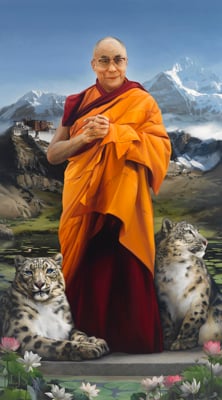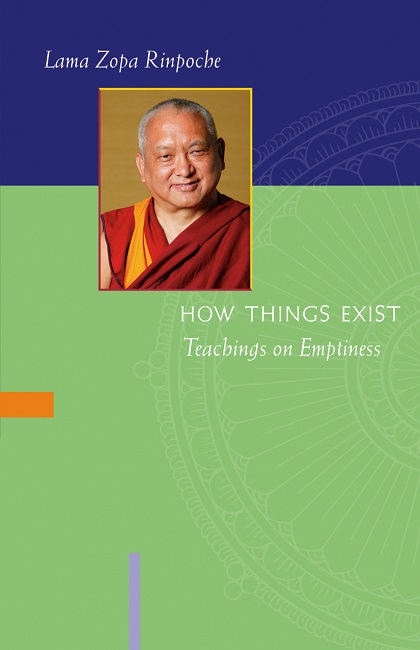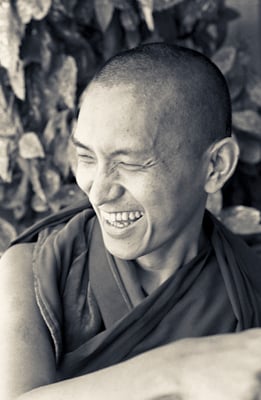Dear LYWA friends and supporters,
Thank you so much for your kind interest in and support of the Lama Yeshe Wisdom Archive.
Spreading Peace and Happiness Together
As you probably know by now, we’re currently in the midst of our midyear fund raising campaign, which we’re winding up with this month’s eletter. Thanks to your generous support, we've raised just over $33,000 towards our $50,000 goal.
Between now and the end of the year we're hoping to publish four more books by Lama Zopa Rinpoche. Fortunately, these books have all been sponsored. Unfortunately, the infrastructure that allows them to happen has not. Your support not only helps to pay for crucial staff but also invests in the technology that, behind the scenes, is the backbone of the Archive.
As Lama Zopa Rinpoche has said about supporting the Archive:
When you contribute to the Archive, you create the charity of Dharma, the highest form of giving. Moreover, when you donate money to the Archive, you accomplish material charity. And since the Dharma teachings show readers how to protect themselves from suffering, you also accomplish the charity of saving others from fear. Thus, by the one action, supporting the Archive, you achieve all three forms of generosity. If, on top of that, you give with bodhicitta--the determination to attain buddhahood for the sake of all sentient beings--your donation becomes the cause of enlightenment.
 If you are able, please consider becoming a Member of Lama Yeshe Wisdom Archive with your donation of US$1,000 or more. See our website for details on the benefits of Membership. If you make your US$1,000 donation today, you will receive all the usual Member benefits plus a beautiful 16x20 matted print of Lisa Sawlit's spectacular portrait of His Holiness the Dalai Lama. [Please note: As of 2020, this is no longer available.]
If you are able, please consider becoming a Member of Lama Yeshe Wisdom Archive with your donation of US$1,000 or more. See our website for details on the benefits of Membership. If you make your US$1,000 donation today, you will receive all the usual Member benefits plus a beautiful 16x20 matted print of Lisa Sawlit's spectacular portrait of His Holiness the Dalai Lama. [Please note: As of 2020, this is no longer available.]
We are offering donors of $100 or more to our mid-year appeal a free copy of Lama Yeshe's When the Chocolate Runs Out. If you made a donation in June and want to receive the book, send an email to Jen.
Donors of $50 or more will automatically receive the next free book we publish, most likely Rinpoche's next book in the Heart Advice Series on refuge.
Visit our website at www.LamaYeshe.com and click on the "Donate Now" button. Thank you!
What's New On Our Website
You can read Lama Zopa Rinpoche's commentary on nyung nä practice given in Aptos CA in July 2000. It was lightly edited by Ven. Ailsa Cameron.
 We have just posted the redesigned and updated ebook version of Lama Zopa Rinpoche's How Things Exist to our Members Area. We now have 14 free ebooks available to Members for downloading in a variety of formats. Remember there are also dozens of print-quality images that can be downloaded for free as well. For more information about our Membership program, please see our website.
We have just posted the redesigned and updated ebook version of Lama Zopa Rinpoche's How Things Exist to our Members Area. We now have 14 free ebooks available to Members for downloading in a variety of formats. Remember there are also dozens of print-quality images that can be downloaded for free as well. For more information about our Membership program, please see our website.
We have also posted excerpts from Rinpoche's teachings at the 43rd Kopan Course in 2010. These include a teaching Rinpoche gave about the life of Khunu Lama, a teaching on how to be mindful of emptiness in daily life, and a teaching on how nothing is definite in samsara. Another excerpt on how to best "take care of yourself" is this month's eletter teaching below.
You can also read the entire transcript of Rinpoche's teachings from the 2010 course. And see this list of all the Kopan Courses we have posted on our website--25 so far-- dating from 1972 to 2010.
New Advices from Lama Zopa Rinpoche
This month we posted advice Rinpoche gave on helping others; Rinpoche says:
Helping others is the most important thing—more than anything else. All your wishes for any happiness will succeed. All good things will come to you because of that.
Every action with a positive or negative mind has consequences as a result. Actions done with a good heart—without anger, without ignorance, without desire, without attachment— result in happiness. Happiness comes from good actions.
Other beings need our help so much. It is best to think of others’ happiness. By doing good things for others—if we help others with a good heart, love and compassion—this results in happiness.
Making others physically and mentally happy, this one act makes both you and others happy for all your future lives. This brings happiness to the whole world.
You can also read Rinpoche's message from 2009 regarding offering service in the FPMT, and advice on how to handle obstacles to guru devotion. As always, you can see a list of all new advices added in the past month here.
When Being A Vegetarian Isn't Enough
I was recently asked to write an article on why I became a vegan for the current online edition of Mandala Magazine. Along with it I edited Rinpoche’s reply to my question about promoting veganism in the FPMT; you can find a link to that exchange in the article. Please check them out.
I also want to remind you about the special practices recommended by Khadro-la for Lama Zopa Rinpoche's good health and long life. All students of Rinpoche's are still strongly encouraged to do these practices and to report their totals to the FPMT International Office. As Ven. Roger said in a recent email:
If you take a little time to think of how each of us has benefited so much from Rinpoche’s teachings and example … such a source of inspiration for practice! It is easy to make a little time with others or alone to generate a good motivation and do one of the practices requested. In fact dedicating any merit created from any virtuous action you do to purifying the karmic view of seeing the Guru as unwell is beneficial.
So please check out the FPMT website and do all you can.
As mentioned above, we leave you with a wonderful teaching from Rinpoche from the 2010 Kopan course. Thank you so much for your kind support. We could not spread the Dharma without you!
Much love, 
Nick Ribush
Director
This Month's Teaching: Taking Care of Ourselves
 When we say we “look after ourselves” or we “take care of ourselves,” what does that mean? In our daily life, whenever we practice Dharma we’re taking care of ourselves; whenever we practice meditation, we’re taking care of ourselves. Now when I say “meditation,” I mean lamrim meditation. This is not what many people call meditation, not what just anybody calls meditation, but lamrim meditation—from guru devotion to tantric meditation, with the two stages, all done with renunciation, bodhicitta and right view—is the real meditation.
When we say we “look after ourselves” or we “take care of ourselves,” what does that mean? In our daily life, whenever we practice Dharma we’re taking care of ourselves; whenever we practice meditation, we’re taking care of ourselves. Now when I say “meditation,” I mean lamrim meditation. This is not what many people call meditation, not what just anybody calls meditation, but lamrim meditation—from guru devotion to tantric meditation, with the two stages, all done with renunciation, bodhicitta and right view—is the real meditation.
Then, even practicing Highest Yoga Tantra, secret mantra, Vajrayana, because we practice it with the lamrim—with renunciation, bodhicitta and right view —it becomes the cause to achieve liberation from the oceans of samsaric suffering and its causes. Practicing with bodhicitta, it becomes the cause to achieve enlightenment. If we’re practicing with the right view, it becomes the antidote to samsara and its root, by eliminating, or cutting, ignorance. It doesn’t become the cause of samsara, the cause of delusion; instead it becomes the antidote, that which eliminates ignorance, the delusions.
So, this is what I mean when I talk about meditation and it's not what many people in the world call “meditation.” I’m not including everything called meditation. There are meditations where we can destroy our mind; there are meditations where we can destroy our Dharma wisdom. There are practices people do that they call meditation, which actually cause them to remain in samsara—to be reborn in the lower realms in particular by developing and increasing their delusions. That’s not really meditation, but those individual people call it “meditation.” I’m not counting those things.
Whenever we’re practicing Dharma in daily life, we’re taking care of ourselves, we’re looking after ourselves. Whenever we’re practicing meditation, as I explained, the lamrim meditations, then we’re looking after ourselves; we’re taking care of ourselves.
Whenever we’re practicing guru devotion, seeing the guru as a buddha, we’re taking care of ourselves, we’re looking after ourselves. Whenever we’re practicing renunciation, we’re taking care of ourselves. Whenever we practice right view, we’re looking after ourselves; we’re taking care of ourselves.
We’re taking care of ourselves, we’re looking after ourselves, and we’re protecting ourselves from suffering and its causes; from problems. By protecting ourselves from the cause of the suffering, the delusions, we’re protecting ourselves from anger, attachment and ignorance. That’s the real protection; that’s the real taking care of ourselves or looking after ourselves. Do you understand?
So the definition of “taking care” or “looking after” actually means practicing Dharma. When we’re not practicing Dharma, we’re following the delusions—we’re following anger, attachment and ignorance. We become their servant, we become their slave. We become a slave to the delusions, a slave to attachment and anger.
When we become a slave to anger, we try to harm our enemies. We spend our time making plans how to harm them, how to destroy them, how to no longer have any enemies in the world. We make plans, including wars—when it becomes very big, it becomes war. When our plan becomes to destroy all enemies and have power, then it becomes war and many millions of people get killed, many millions of people have to suffer for our happiness, so we won’t have enemies. Many millions of people have to suffer, have to be killed, can you imagine? This is without counting the animals that die in the oceans and on the ground from the bombs we drop.
When we follow the three poisonous minds, when we become a slave to the three poisonous minds, then we’re not taking care of ourselves, we’re not looking after ourselves. By becoming their slave, by following the delusions, then they harm us constantly, torturing us and forcing us to suffer. By creating karma motivated by the delusions, the result is suffering now and in the future, continuously. Following ignorance, anger, attachment, the delusions, is regarded as taking care of ourselves, but that’s the wrong understanding of taking care, it’s a wrong view. And if we’re not taking care of ourselves, we’re harming ourselves.
When we follow the three principal aspects of the path to enlightenment, that’s taking care of ourselves. Then, of course, on top of that there’s the tantric path.
The best way of taking care of our life is living our life with bodhicitta. That’s the best way of taking care, making our life most meaningful, so it is most beneficial to us and most beneficial to others who are numberless. That is making our life most beneficial to numberless sentient beings. Living our life with bodhicitta—that’s the best way of taking care of our life. Protecting our own life with bodhicitta—that’s the best protection.
Kyabje Lama Zopa Rinpoche gave this teaching at Kopan Course No. 43, held at Kopan Monastery, Nepal, in Nov-Dec, 2010. This is an excerpt from Lecture Three of the course. Lightly edited by Sandra Smith and Nick Ribush.































